Tamara Thiessen explores the curvaceous coast, dramatic cliffs and mountainous hinterland of the Mediterranean island of Corsica, as she cycles the French island’s rollercoaster Tour de France-featured routes.
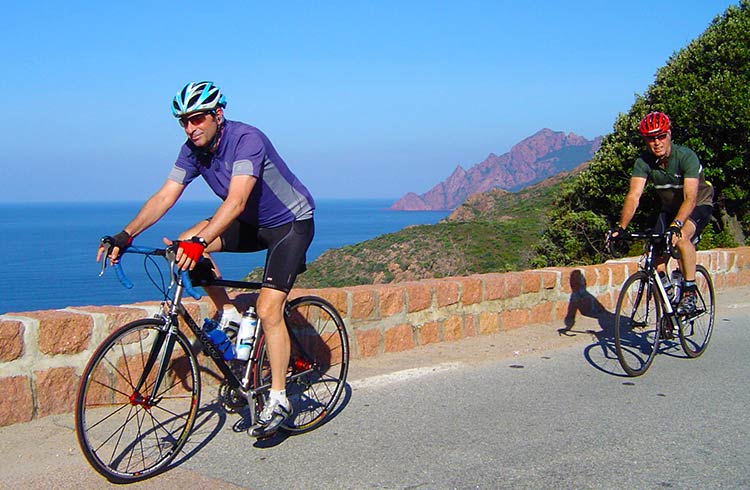 Photo © Tamara Thiessen
Photo © Tamara Thiessen
Resting on my handlebars, high over a teetering limestone precipice on the southern coast of Corsica, alongside me is the medieval town of Bonifacio – the Città alta – and its clifftop citadel.
Below, beyond the pretty little harbor and a huddle of orange-hued stone houses, is the vertical limestone sea stack known as U Diu Grossu (“big finger” in Corsican dialect), and just visible, 7.5mi (12km) across the Strait of Bonifacio, I can see the Italian island of Sardegna (Sardinia), once part of the same Roman province.
- Cycling the 2013 Tour de France Route
- What to Expect
- Porto Vecchio to Bonifacio
- Figari to Ajaccio
- Ajaccio to Calvi
- Trip Notes
Cycling the 2013 Tour de France Route
As an islophile, I have always been irresistibly drawn to islands for all kinds of outdoor adventures, from hiking to cycling. On top of its incredible coastline with 200 beaches, Corsica is a ready-made biking trip.
On my first cycling assault of Corsica, in August 2013, the island was still riding high on Tour de France frenzy after being selected as the race kick-off point for its 100th edition.
Now, five years later, I choose the low-season month of October, where height-of-summer crowds and temperatures are at bay, and road riding is quieter, too.
What to Expect
The Tour de France routes take in many scenic highlights, north to south, east to west, and inland including rustic villages, goat-filled valleys, nature reserves and mountain saddles. But they don’t have to be tackled at a pro’s pace – the island terrain is tough enough as it is; dozens of peaks and folds are compressed with origami-like complexity into its 3,350sq.mi (8,681km2).
For an island that is just 113mi (183km) long and 51mi (83km) wide, it has 21 peaks rising above 6,560ft (2,000m), and more than 150 cols (alpine passes); no wonder Corsica is often referred to as the ‘the Mountain in the Sea’.
This all boils down to a hurly burly ride for cyclists, and a 10-speed road bike and good fitness levels are necessary for tackling the predominantly undulating roads.

Porto Vecchio to Bonifacio
There are three tour stages to tackle in Corsica. This time, I pick out a couple of legs I skipped in 2013, starting with the beginning section of Stage One, a 41mi (67km) from Porto Vecchio to Bonifacio, which I hope to complete in one day.
The Grand Départ – first leg of the race – starts between mountain and sea in the east coast port city of Porto Vecchio, then swoops down to the southernmost point of Corsica, Bonifacio, through some typically sharp bends and descents, which are an immediate test on my breaks and nerves.

Nonetheless, on 'the island of 10,000 bends', my first day is a relatively easy ride with a 2,821ft (860m) climb – compared to the 6,233ft (1,900m) ascent on Corsica’s Stage Two of the Tour, through the vertiginous alpine hinterland from Bastia to Ajaccio, which I conquered over five-days on my 2013 trip.
Around me, an almost impenetrable green carpeting of maquis (scrubland vegetation found in the Mediterranean region) camouflages about 40% of the island, amid chestnut, pine and myrtle trees, and more than 2,000 plant and flower species.
It’s hard to beat the Corsican food for essential fuel. A culinary-cultural fusion of native and Italian flavors, meat is served with pulenta as opposed to polenta, lasagna is made with wild pig, and cannellonis au brocciu with fresh ewe’s milk cheese, laden with garlic and silver beet.
Along the way I picnic on rustic Corsican cheeses with chestnut flour bread, and develop a dangerous addiction for canistrelli biscuits, flavored with coconut, walnuts and aniseed.
I pass up Bonifacio’s five-star hotels for a typical rural bolthole in Figari, a further 12.5mi (20km) away, where I soak up the island’s renowned hospitality (and food) at a stone-walled farmhouse.
Figari to Ajaccio
A couple of days later, aiming for a leisurely 32mi (50km) or so a day (about four hours of solid riding) I arrive in the Corsican capital Ajaccio (Aiacciu), Napoleon’s birthplace, with pretty pastel-colored houses in the old town, a palm-lined port and elegant public squares.
Napoleon – so-called ‘petit Corse’ and ‘avenger of Corsica’ – was born in 1769 to Italian parents as Nabulione di Buonaparte. A year earlier, France had won Corsica from the Italian city-state of Genoa, leaving locals disgruntled at outside interference, and with a fiery independence streak.
A battle for greater autonomy, waged by several militant nationalist groups since the 1970s, simmers away in the backdrop, but poses no threat to travelers, and in Ajaccio, I see several old posters plastered about town, where national and Tour de France pride collide.
I soak up its Italian dolce vita over pasta and espresso in a café in Cours Napoléon, part of the old town center, before continuing my ride to Calvi the next day.
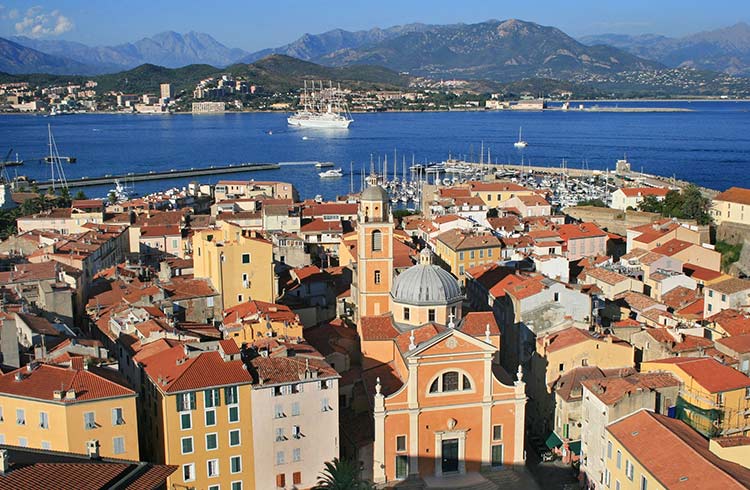
Ajaccio to Calvi
A thigh-burning 80mi (130km) awaits me over the next three days as I peddle north along the narrow west coast roads between Ajaccio and Calvi, through five mountain passes, on the big dipper ride.
Stage Three of the Tour starts with a spectacular and rather hairy 8,850ft (2,700m) ascent, then similar descent, where I find myself suspended almost barrier-less over the Mediterranean.
Corsica’s beauty reaches new heights here, along with the hills, and gives me the strength to carry on, particularly through the UNESCO-listed site of the Calanches de Piana cliffs to the Gulf of Porto. Tooth-edged, crimson cliffs sculptured into an astounding menagerie of shapes and forms loom 984ft (300m) over the coastal road.
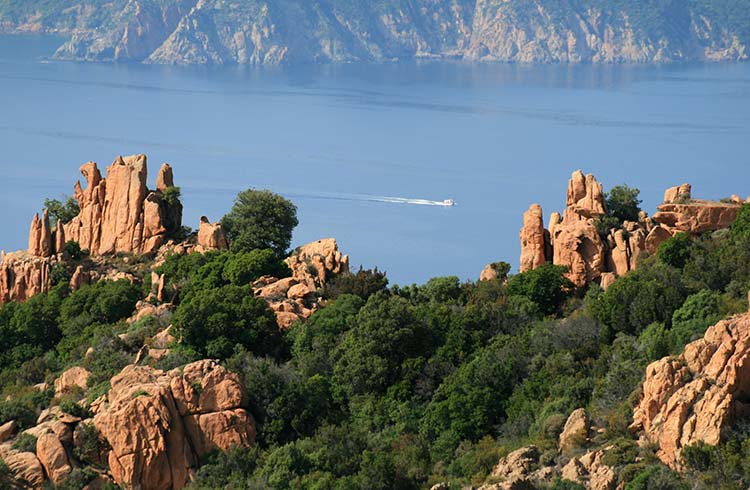
After six days of riding, I feel proud to have officially completed the three Tour de France stages – over two trips. But that doesn’t mean I won’t be back to cycle the island again – once I’m over my saddle soreness, I’ll get planning.
Trip Notes
Getting there
Air Corsica offer direct flights year-round from Nice and Paris Orly Airport. Between April and October, you can fly from London to Ajaccio, Bastia, Calvi and Figari on Corsica.
Ferries go from several French and Italian ports. It’s advised to book in advance, but not mandatory.
When to go
Travel during low season in Spring (September–October) or Fall (May–June), when the weather is still warm with daily temperatures ranging from 51.8°F/ 11°C to 77°F/ 25°C.
Bike hire
Corse Location Velo have several road bike models for hire at great prices (seven days for US $250/220 Euro), and deliver to key locations all over the island.
The other option is to pay for a self-guided bike tour or join a specialist cycling tour company, such as Province-based Active Vacations.
With AppeBike (an electric bike hire mobile application) you can rent bikes by the half hour or week, and drop it at a station of the network, from Bastia and Bonifacio to Ajaccio and Calvi.
How to get around Corsica
By bike, hire car, or bus and taxi. Check out CorsicaBus.org for prices of bike carriage on some services.
What to pack
Comfy sporting gear including padded shorts, light sweater and pants for cooler evenings; helmet, water bottle and snacks, sunglasses and sunscreen, puncture kit and pump, route map, and plenty of cash for country tripping.
Related articles
Simple and flexible travel insurance
You can buy at home or while traveling, and claim online from anywhere in the world. With 150+ adventure activities covered and 24/7 emergency assistance.
Get a quote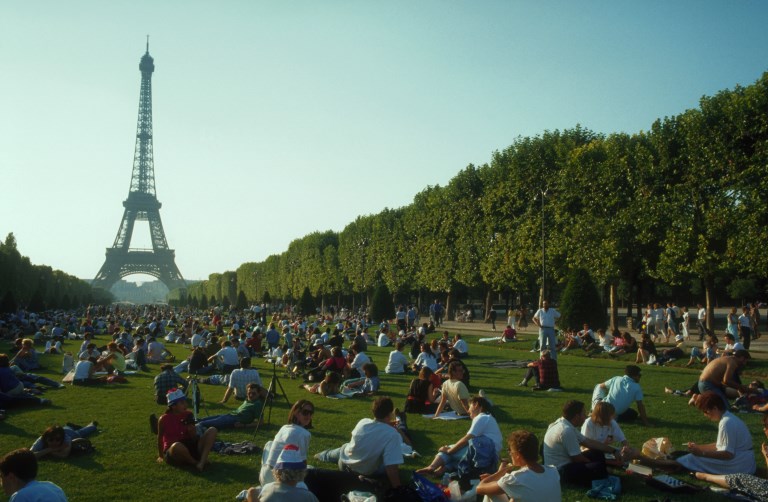
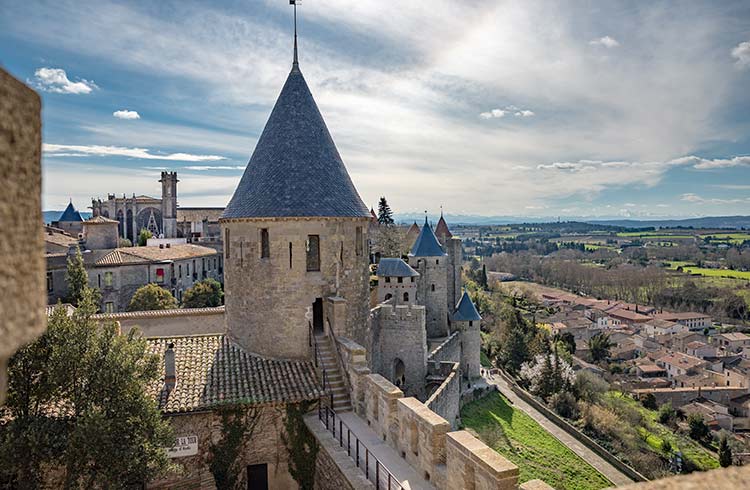
1 Comment
Outstanding!